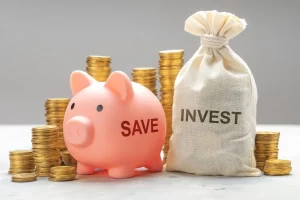- Investments
What Is an Investment and How to Start from Scratch

Investing is one of the best ways to grow your money over time, yet many people don’t know where to begin. Whether you’re starting with $50 or $5,000, understanding how investments work helps you build wealth and achieve financial security.
In this guide, we’ll explain what an investment is, the different types of investments, and how to start investing even as a beginner.
1. What Is an Investment?
An investment is any asset or financial product that you buy with the expectation that it will increase in value over time.
✅ How Investments Work:
✔ You put money into an asset (stocks, real estate, bonds, etc.).
✔ Over time, the asset grows in value or generates income (dividends, rent, or interest).
✔ You can sell the asset later for a profit or continue earning passive income.
🚀 Example: If you invest $1,000 in stocks and the value grows by 8% per year, in 10 years, your investment could be worth $2,159—without adding more money.
💡 Tip: Investing helps your money outpace inflation, meaning your savings don’t lose value over time.
2. Why Should You Start Investing?
Keeping money in a savings account is safe, but it doesn’t grow much. Investing makes your money work for you.
✅ Benefits of Investing:
✔ Compounds growth over time—your earnings generate more earnings.
✔ Helps you build wealth faster than saving alone.
✔ Provides passive income (dividends, interest, rental income).
✔ Allows you to retire comfortably by growing a strong financial portfolio.
🚀 Example: If you invest $200 per month at an average 8% return, after 30 years, you’ll have $271,000+—compared to just $72,000 if you kept it in a savings account.
💡 Tip: The earlier you start investing, the more time your money has to grow.
3. Understanding Different Types of Investments
There are various ways to invest, each with different risks and rewards.
✅ Main Types of Investments:
✔ Stocks – Buying shares in a company to benefit from its growth.
✔ Bonds – Lending money to companies or governments for fixed interest payments.
✔ Real Estate – Investing in property to earn rental income or capital appreciation.
✔ Mutual Funds & ETFs – Investing in a group of stocks or bonds for diversification.
✔ Cryptocurrencies – Digital assets like Bitcoin and Ethereum, known for high volatility.
🚀 Example: Stocks generally offer higher returns but more risk, while bonds provide stable, lower returns.
💡 Tip: Beginners should start with low-risk investments like index funds before moving to higher-risk options.
4. How to Start Investing from Scratch
You don’t need a lot of money to start investing—just the right strategy.
✅ Step-by-Step Guide to Start Investing:
✔ Step 1: Define your investment goal (retirement, passive income, wealth growth).
✔ Step 2: Choose the right type of investment for your risk tolerance.
✔ Step 3: Open an investment account (brokerage, retirement account, robo-advisor).
✔ Step 4: Start with a small amount and invest consistently.
✔ Step 5: Reinvest profits to maximize growth.
🚀 Example: If you invest $50 per month in an index fund, it can still grow significantly over time.
💡 Tip: Don’t wait until you have a large sum—start small and build over time.
5. The Power of Compound Interest in Investing
One of the biggest advantages of investing is compound interest—your money earns interest, and that interest earns even more interest.
✅ How Compound Interest Works:
✔ You invest money.
✔ Your investment earns returns.
✔ Your returns are reinvested, increasing future earnings.
🚀 Example: If you invest $5,000 at 8% interest, in 20 years, it becomes $23,304 without adding more money.
💡 Tip: The earlier you invest, the bigger the compound effect.
6. Understanding Investment Risks and Rewards
All investments involve some level of risk, but higher risk often means higher potential returns.
✅ Risk Levels of Different Investments:
✔ Low Risk – Savings accounts, bonds, fixed income.
✔ Medium Risk – ETFs, mutual funds, real estate.
✔ High Risk – Individual stocks, cryptocurrencies, startups.
🚀 Example: Investing in a high-risk startup might double your money, but it could also lose value quickly.
💡 Tip: Always diversify—never put all your money into one investment.
7. Common Mistakes to Avoid as a Beginner Investor
Many new investors lose money by making avoidable mistakes.
❌ Investment Mistakes to Avoid:
✔ Investing without research.
✔ Trying to get rich quickly instead of long-term growth.
✔ Selling investments when the market drops instead of waiting for recovery.
✔ Putting all money into one type of investment.
🚀 Example: If you panic-sell stocks during a market downturn, you lock in losses instead of waiting for recovery.
💡 Tip: Always invest with a long-term mindset.
8. Tools and Platforms to Start Investing
Choosing the right investment platform makes it easier to start.
✅ Best Investment Platforms for Beginners:
✔ Brokerage Accounts – Fidelity, Charles Schwab, TD Ameritrade.
✔ Robo-Advisors – Betterment, Wealthfront (automate investments).
✔ Micro-Investing Apps – Acorns, Stash (start with small amounts).
✔ Crypto Exchanges – Coinbase, Binance (for cryptocurrency investing).
🚀 Example: Using a robo-advisor allows you to invest automatically with little effort.
💡 Tip: Choose a platform with low fees to keep more of your investment returns.
9. How to Stay Consistent and Keep Learning
Successful investors keep learning and adjusting their strategy.
✅ Ways to Improve as an Investor:
✔ Read investing books (The Intelligent Investor, The Little Book of Common Sense Investing).
✔ Follow finance blogs and YouTube channels.
✔ Keep investing consistently, even during market downturns.
🚀 Example: Someone who invests $200 per month for 30 years will build more wealth than someone who invests $5,000 once and stops.
💡 Tip: Investing is a lifelong journey—always stay informed and adapt.
Final Thoughts
Investing is not just for the wealthy—anyone can start, no matter their income level.
✔ Understand what an investment is and why it matters.
✔ Learn about different types of investments and their risks.
✔ Start small, invest consistently, and let compound interest work for you.
✔ Use the right investment platforms and tools for beginners.
✔ Keep learning and adjust your investment strategy over time.
🚀 The sooner you start investing, the faster you can grow your wealth—start today!






